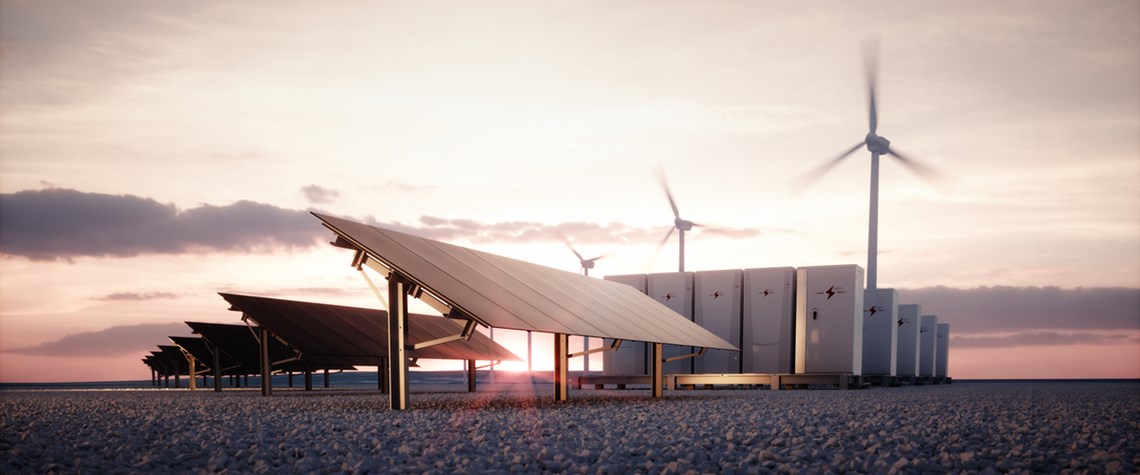You can read more stories like this by subscribing to our monthly Energy Transition newsletter here
Norton Rose Fulbright recently represented the lenders on the financing for the world’s largest operational solar-plus-storage system, located in Hawaii. Financing solar-plus-storage projects requires working through unique contractual, regulatory and legal issues. Despite the acceleration in storage deployment seen over the last few years, market practice is still developing on key issues. This article describes some of the key reasons why solar-plus-storage projects are beginning to proliferate and shares three key lessons for financing solar-plus-storage projects in the US.
The rise of solar energy
Solar energy has seen explosive growth over the last decade, growing from 0.1pc of the US’s total energy generation in 2010 to over 2.5pc today. Last year, solar energy accounted for 40pc of new electricity-generating capacity in the US, and this year solar is expected to make up 33pc of new capacity even taking into account the impacts of the pandemic and economic downturn.
The key drivers are rapidly declining technology costs and increased demand. Demand has been boosted not only by utility procurements but also by large corporations looking to meet aggressive corporate sustainability commitments.
Corporate renewable purchases globally were up 40pc in 2019 compared to 2018, with one US state alone—Texas—accounting for more than a quarter of those deals. The largest buyers were technology companies and oil and gas companies. The latter are facing increasing pressure from investors to power their operations with renewables and diversify investments with low-carbon technologies.
At a more macro level, the oil and gas industry is still reeling from the impacts of the pandemic that caused severe downward pressure on oil prices earlier this year. Royalties paid to landowners and local governments by the developers who wish to site solar projects in rural areas in certain parts of the country can increase local support for these projects, especially if the landowners are no longer receiving royalties from oil companies, which are pulling up their drilling rigs due to the COVID-19 downturn.
Benefits of adding storage
In its most popular form, a solar-plus-storage project consists of a battery storage system connected to a solar PV system such that the battery is charged from the solar system with the energy not exported to the grid and then discharged to the grid at a later time when the energy is needed most. Storage helps match energy supply with demand and alleviate the intermittency problem of renewables.
According to one study carried out by the investor owned utilities in California, solar projects with four hours of storage are expected to have a 99.8% “effective load carrying capacity” in 2022 (essentially, how much of a project’s capacity can be counted on at any given time), as compared to only 6.2% for a project without storage. This shows that a solar-plus-storage project is much more beneficial in terms of grid stability than just a solar project. The government and relevant regulatory bodies are likely to encourage development of energy storage to take advantage of this benefit. Adding storage to a solar project will also make it harder for other technologies to compete that are traditionally seen as more reliable, including gas plants (especially peaker plants that run infrequently).
In addition, adding storage to solar also helps mitigate curtailment. The daily peak in solar production does not typically coincide with the peak in demand. When supply exceeds demand, the grid operator curtails (or reduces) production. In California, for example, this has led to increasing amounts of curtailed solar production, especially in the spring. By adding storage, the energy that would otherwise not be produced and sold can be stored and used later in the day when demand increases but solar production is lower (or non-existent). This feature can increase the value of solar projects.
Lessons for financing projects
Here are three lessons for financing solar-plus-storage projects in the US:
- Performance guarantees and warranties from creditworthy counterparties are a must for addressing key technology risks
Storage projects have a shorter operating track record than gas, wind and solar ones because the technology is newer. Project finance lenders and tax equity investors do not like technology risk. The key technology risk in a storage project is capacity degradation. Financiers will look for a performance guarantee or capacity maintenance agreement under which the service provider refreshes the battery with new cells to maintain capacity at minimum, albeit decreasing, levels over time.
The cost of disposal and recycling of the old cells should be factored into the model if the service provider has not assumed responsibility. Lenders may also want to build a reserve account into the financing documents to cover above-warranty cell replacement costs. The creditworthiness of the performance guarantor and warranty provider is critical. Insurance products may be available to bolster weak financials.
- The owner takes on more risk if the project lacks a full-wrap EPC contract
Split EPC contracts are more common in solar-plus-storage projects than in pure solar projects. Project lenders and tax equity investors have historically preferred a fixed-price, turnkey EPC contract that shifts as much risk as possible from the owner to a single EPC contractor. In contrast, a split structure may have multiple equipment supply, construction and installation contracts.
There is more risk for the project owner (and its financing parties) under a split arrangement than a full-wrap structure. Splitting these contracts creates interface risk (both logistical and technological) as well as results in lost time and finger-pointing when trying to sort out responsibility for any defects or issues.
Construction lenders and tax equity investors will assess the ‘bankability’ of split EPC contracts by assessing whether the additional risk exposure is sufficiently mitigated. Thorough technical and legal review will be at the heart of this analysis.
- Contracts should ensure adherence to ITC rules if the project relies on tax equity financing
Batteries that are combined with solar projects on which investment tax credits (ITCs) are claimed potentially qualify for such a tax credit.
To be eligible for the ITC, at least 75pc of the energy stored by the battery should come from the solar project to which it is coupled. Lenders and tax equity investors will want a covenant in the loan agreement and tax equity documents requiring the sponsor to ensure exclusive charging from the linked solar facility during the first five years of operation during which any tax credit claimed remains exposed to recapture. To the extent the offtaker has a right to control charging, the owner may want to build in a right to recover any ITC-related recapture or losses in the power-purchase agreement.
Looking ahead
Solar-plus-storage projects are expected to continue to play an important role in the US energy market as equipment costs come down, renewable energy procurement gathers steam and lenders and investors gain confidence with the technology.
As this area expands, one key issue to watch will be the evolving regulatory framework. In the US, market rules for storage can vary widely depending on the geographic area in which the project is located. At the federal level, new tariffs, trade and national security policies may impact procurement of solar and storage system components.








Comments